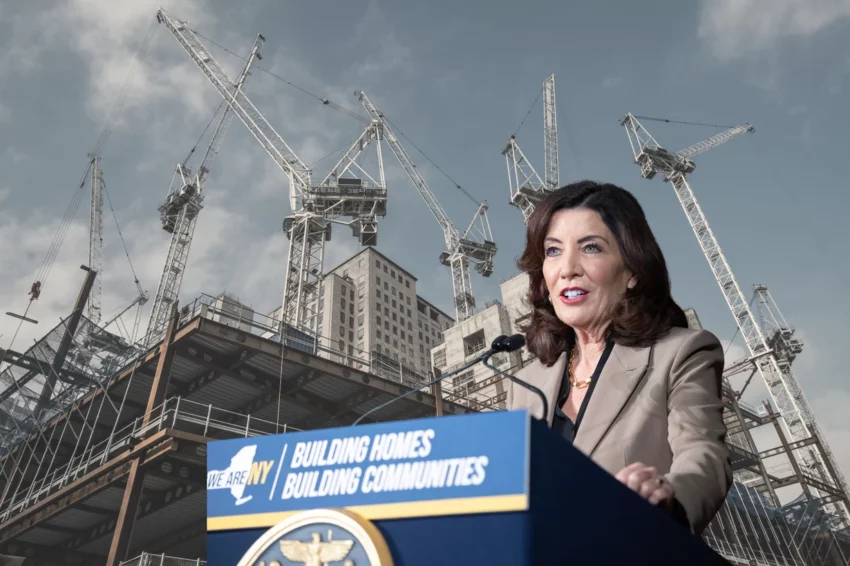This story originally appeared in New York Focus, a nonprofit news publication investigating power in New York. Sign up for their newsletter here.
BUDGET · April 22, 2024
Albany’s New Housing Plan Would Build Only a Fraction of the Housing New York Leaders Say Is Needed
It’s the first step New York has taken to address its housing shortage in years — but tenant groups are fuming and real estate wants more.
By Sam Mellins , New York Focus
After months of negotiations, lawmakers in Albany reached a deal over the weekend containing a series of measures — tax credits, tenant protections, and zoning changes — meant to address New York’s dire housing crisis.
Announcing the plan last week, Governor Kathy Hochul declared victory in her mission to tackle New York’s shortage of homes, which she has long said is her top priority among housing issues.
“I refused to accept anything that didn’t meaningfully address the housing supply,” Hochul said last week, calling the agreement “the most comprehensive housing policy our state has seen in three generations.”
The plan will likely create tens of thousands of new homes, but it’s a far less ambitious plan than she pushed last year, when she insisted — and legislative leaders agreed — that New York needed hundreds of thousands more.
In 2023, Hochul’s signature policy proposal was the so-called Housing Compact, which she said would double New York’s rate of housing construction and lead to 400,000 more homes across the state in the next decade than would have been created without the plan.
This year’s deal, which Hochul called “transformative,” will likely add only a fraction of that amount.
Housing growth projections are inherently imprecise, since development is shaped by shifting factors like interest rates, the cost of labor and land, and population trends. But the budget indicates that housing growth under the plan will largely be limited to New York City, rather than parts of the state where Hochul and numerous housing experts have said more housing is necessary to tackle New York’s affordability crisis.
Almost all of the 400,000 homes Hochul predicted her 2023 plan would unlock came from two measures that are absent from this year’s plan: a housing growth requirement for every municipality in the state and a requirement that towns allow dense housing near train stations.
Those measures were particularly aimed at New York City’s suburbs, which build less housing per capita than nearly any other major city’s suburbs nationwide — and whose politicians mounted fierce resistance to the 2023 plan, ultimately killing it.
This year’s housing deal imposes no requirements on the suburbs. Instead, it includes measures that will likely have a much smaller impact: offering state funds to localities that take steps to boost housing and creating a new statewide tax break for apartment developers who include subsidized units in their buildings.
Financial incentives for towns have historically been ineffective at spurring new housing. The Hochul administration acknowledged as much last year in a presentation, stating that “Relying solely on incentives has failed in other states.”
Another measure in the budget could be more effective: a tax break for apartment developers outside New York City. The measure will allow towns to partly exempt new apartment buildings from property taxes for 25 years after they’re completed if at least a quarter of its units are set aside for low-income families. Even though local opposition and restrictive zoning tend to be the main obstacles to apartment construction in New York City’s suburbs, a tax break could help grease the wheels.
“If we have a standardized tax credit, I do think we’ll see more interest in developing affordable housing and rental housing outside of New York City,” said Rachel Fee, executive director of the affordable housing advocacy group New York Housing Conference.
The deal also included a $500 million fund for a still-in-formation plan to promote housing development on land owned by the state, which Hochul said could lead to as many as 15,000 new units in coming years, though few details are available to explain how this will happen.
Hochul’s office did not respond to a request for comment for this story.
Andrew Fine, policy director for the group Open New York, which advocates for growing New York’s housing supply, said that this year’s housing package is “better than nothing.”
“But there is too much celebration over Albany doing the bare minimum to support housing growth in New York City,” he added.
The housing package also made significant changes to the laws governing tenants’ rights. Most importantly, it enacted a law allowing tenants to challenge rent increases over 10 percent, or 5 percent plus inflation. The law will apply automatically in New York City, and other parts of the state can opt in. Some tenant groups harshly criticized the measure for its numerous exceptions: It doesn’t apply to landlords who own a small number of units or to new buildings for 30 years, among other carveouts.
Landlord groups also won the right to introduce bigger rent hikes on rent-stabilized apartments following renovations, in a rollback to a part of New York’s landmark 2019 tenant protection law.
The centerpiece of this year’s plan is replacing an expired tax credit for developers that build rental housing in New York City. Known as 421-a, the tax break was used to finance about 8,000 units of housing — 30 percent of them affordable — annually from 2016 to 2021. Proponents saw it as a critical program to make rental construction financially viable, while opponents slammed it as a multibillion dollar giveaway to developers that produced only small amounts of meaningfully affordable housing.
In 2023, Hochul’s office attested that renewing the tax break was necessary just to maintain New York City’s rate of housing production. Since its expiration in 2022, construction in the city has slowed considerably.
The new version of the tax break, known as 485-x, will offer participating developers a 40-year exemption from most property taxes. In exchange, they must rent at least 20 percent of new apartments below market rate, and those units must remain permanently affordable. The developers must also give construction workers that build large apartment buildings significantly elevated minimum wages, ranging from $40 an hour in outlying areas to at least $72 an hour for projects in the city’s wealthiest neighborhoods.
Construction worker unions have been one of the few parties, aside from the governor, celebrating the deal.
“It’s pretty close to what we were asking for or what we were expecting,” said Brett Thomason, political director of the construction union Steamfitters Local 638.
Two other measures in the deal could add several thousand new homes a year in New York City: a tax break to convert office buildings into housing and the elimination of the city’s “floor area ratio cap,” which limits the height of apartment buildings.
Though it’s hard to predict how much housing these changes will create, New York City’s Department of City Planning has estimated that office conversions could add 20,000 homes over the next decade. And a 2015 study from Columbia University estimated that the size limit on apartment buildings reduced New York’s housing supply by nearly 130,000 units in the half-century after its 1961 enactment, averaging out to about 2,500 fewer homes per year.
Matthew Murphy, director of the Furman Center, a housing think tank at New York University, said that while it’s difficult to know how much effect these changes would have, some of the provisions show promise, especially if they’re implemented with low-income tenants in mind.
As part of a citywide housing initiative known as “City of Yes,” Mayor Eric Adams is seeking to create new zoning districts that allow larger apartment buildings than city or state law have so far permitted. He is also promoting the conversion of underused office buildings into housing. Adams’s office has estimated that these and other measures included in the City of Yes package could lead to as many as 100,000 additional homes in New York City over the next 15 years.
The changes agreed to in Albany will smooth the road toward that goal. Last week, Adams released a statement saying he was “thrilled” by the deal and praising its “major package of legislation to grow our affordable housing supply and protect tenants.”

